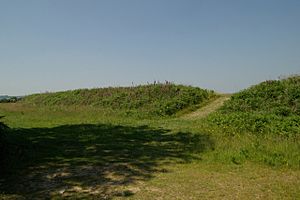Boringdon Camp facts for kids
Boringdon Camp is a very old site in Cann Woods, near Plympton in Devon, England. It was built long ago during the Iron Age and was also used by the Romans. It's an "earthwork," which means it's a structure made from earth, like a fort.
Today, Boringdon Camp is a scheduled ancient monument. This means it's a special place protected by the government because of its historical importance. It is owned by the South Hams District Council.
Contents
What is Boringdon Camp?
Boringdon Camp is an ancient hillfort. A hillfort is a type of fort built on top of a hill. People in the Iron Age built these for protection. They used natural hills to help defend themselves.
Where is Boringdon Camp?
This ancient site sits on a hilltop about 140 meters (460 feet) above sea level. From here, you can see amazing views down the Plym Valley all the way to Plymouth Sound, which is about 11 kilometers (7 miles) away.
The camp is right behind the Cann Wood parking area. This is on the modern road that goes from Plympton to Shaugh Prior.
Why can't I visit Boringdon Camp?
Since 2016, Boringdon Camp has been closed to visitors. There are two main reasons for this:
- Protecting the Earthwork: People walking on the old earth walls were causing them to wear away.
- Protecting Sheep: Sheep graze at the site to help keep it tidy. Sometimes, dogs not on leashes would bother the sheep.
Closing the site helps protect this important historical place and the animals that live there.
What Does Boringdon Camp Look Like?
Boringdon Camp covers an area of about 2 hectares (5 acres). It was built around an even older "ring ditch." A ring ditch is a circular trench dug into the ground.
The main part of the fort is a nearly circular area. It is surrounded by a large earth wall, called a "rampart," which is about 8 meters (26 feet) wide. Outside this rampart, there was a ditch of a similar size. You can still see parts of this ditch today. However, some trees have grown over parts of the defenses, especially near the main entrance.
Old Roads and History
To the east of the fort, there's a raised path. This is what's left of a medieval road. This road used to connect Plympton to Shaugh Prior. People stopped using this road in the early 1800s. Boringdon Camp was officially protected as a scheduled ancient monument in 1939.
Nearby Historical Sites
The area around Boringdon Camp has other interesting historical features. There was once a lead mine and a place to melt the lead nearby. These mining remains are also protected as scheduled monuments.
There were also "deer parks" in the area. A deer park is a large enclosed area where deer were kept, often for hunting. One deer park was set up in Boringdon Wood in 1699. Traces of another deer park from the early 1700s can also still be seen to the east.
Images for kids



